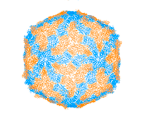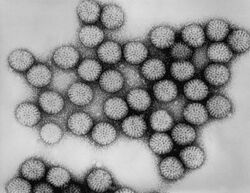Biology:Sedoreovirinae
| Sedoreovirinae | |
|---|---|

| |
| Cryo-EM of protein capsid structure of rice dwarf virus (RDV) | |
| Virus classification | |
| (unranked): | Virus |
| Realm: | Riboviria |
| Kingdom: | Orthornavirae |
| Phylum: | Duplornaviricota |
| Class: | Resentoviricetes |
| Order: | Reovirales |
| Family: | Sedoreoviridae |
| Subfamily: | Sedoreovirinae |
| Genera | |
Sedoreovirinae (sedo = smooth) was a subfamily of the Reoviridae family of viruses.[1] Viruses in this subfamily are distinguished by the absence of a turreted protein on the inner capsid to produce a smooth surface.[2]
Characteristics
Like other members of the Reoviridae family, viruses of the Sedoreovirinae subfamily are made of naked, icosahedral capsids containing 10-12 segments of linear double-stranded RNA (dsRNA). The Baltimore System of viral classification categorizes Reoviridae in Group III.
Importance
Viruses classified in the Sedoreovirinae subfamily infect a wide range of plants and animals, including some that can infect humans. There is not only the potential of a few of these viruses to cause human disease, but also to reduce the supply of crops and livestock.
Viruses

Genus Cardoreovirus
Eriocheir sinensis reovirus was isolated out of a Chinese mitten crab (Eriocheir sinensis). No currently known associated disease.[3]
Genus Mimoreovirus
Microsomonas pusilla reovirus was isolated from the marine protist Micromonas pusilla[4]
Genus Orbivirus
Arboviruses containing dsRNA are placed in this genus. Some Orbivirus infect livestock with high rates of morbidity and mortality.[5] Includes: Bluetongue virus, African horse sickness virus, Epizootic hemorrhagic disease virus, among others.
Genus Phytoreovirus
Known phytoreoviruses are plant pathogens causing dwarfism and the formation of tumors.[6] Included: Rice dwarf virus, Rice gall dwarf virus, and Wound tumor virus.
Genus Rotavirus
Rotavirus A-E cause infantile gastroenteritis in humans and farm animals.[7]
Genus Seadornavirus
Many known Seadornaviruses cause encephalitis in humans. Included: Banna virus, Kadipiro virus, and Liao ning virus.[8]
References
- ↑ "International Committee on Taxonomy of Viruses (ICTV)". https://ictv.global/taxonomy.
- ↑ Viruses, International Committee on Taxonomy of; King, Andrew MQ (8 November 2011). Virus Taxonomy: Ninth Report of the International Committee on Taxonomy of Viruses. Elsevier. ISBN 9780123846846. https://books.google.com/books?id=KXRCYay3pH4C. Retrieved 20 December 2018.
- ↑ Zhang S; Shi Z; Zhang J; Bonami JR (December 2004). "Purification and characterization of a new reovirus from the Chinese mitten crab, Eriocheir sinensis". Journal of Fish Diseases 27 (12): 687–92. doi:10.1111/j.1365-2761.2004.00587.x. PMID 15575876.
- ↑ Attoui H; Jaafar FM; Belhouchet M; de Micco P; de Lamballerie X; Brussaard CP (May 2006). "Micromonas pusilla reovirus: a new member of the family Reoviridae assigned to a novel proposed genus (Mimoreovirus)". The Journal of General Virology 87 (Pt 5): 1375–83. doi:10.1099/vir.0.81584-0. PMID 16603541.
- ↑ Firth AE (2008). "Bioinformatic analysis suggests that the Orbivirus VP6 cistron encodes an overlapping gene". Virology Journal 5: 48. doi:10.1186/1743-422X-5-48. PMID 18489030.
- ↑ Wei T; Uehara-Ichiki T; Miyazaki N; Hibino H; Iwasaki K; Omura T (October 2009). "Association of Rice gall dwarf virus with microtubules is necessary for viral release from cultured insect vector cells". Journal of Virology 83 (20): 10830–5. doi:10.1128/JVI.01067-09. PMID 19640979.
- ↑ "Rotavirus | Home | Gastroenteritis | CDC". https://www.cdc.gov/rotavirus/index.html?s_cid=cs_281%5B%5D.
- ↑ "Liao ning virus in China". Virology Journal 8: 282. 2011. doi:10.1186/1743-422X-8-282. PMID 21649929.
Wikidata ☰ Q16992486 entry
 |

